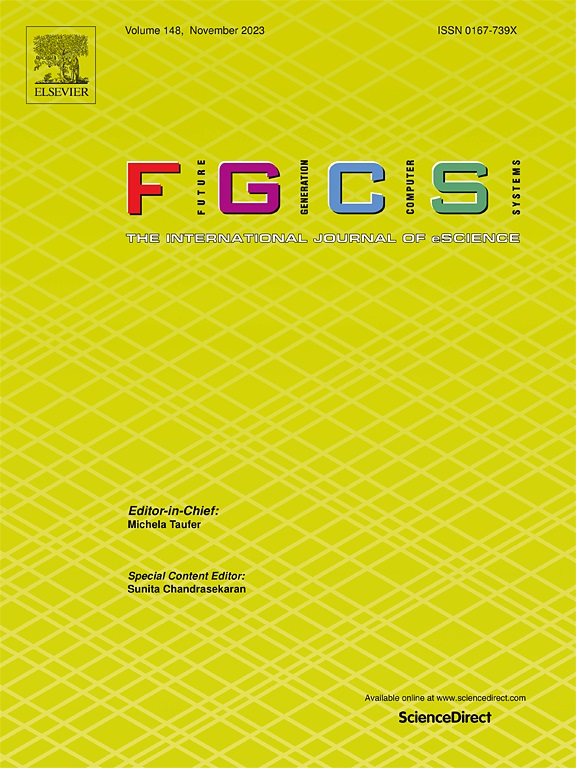HS-GIoV:用于自动驾驶低延迟推理的高速绿色车联网边缘辅助模型
IF 6.2
2区 计算机科学
Q1 COMPUTER SCIENCE, THEORY & METHODS
Future Generation Computer Systems-The International Journal of Escience
Pub Date : 2025-03-20
DOI:10.1016/j.future.2025.107817
引用次数: 0
摘要
绿色车联网已经成为未来智能交通系统(ITS)与绿色无线通信和计算智能相结合的自动驾驶领域的潜在解决方案。它有助于增强交通管理应用,减少交通拥堵和兼容的V2X连接。然而,GIoV在为实时视频分析提供无缝带宽方面面临着重大挑战,尤其是在恶劣环境下,同时还要提高自动驾驶的准确性。虽然深度神经网络(DNN)在定位车辆方面是有效的,但它们难以频繁访问边缘网络并保持准确性。此外,它们大量的计算需求浪费了能源,使它们无法部署在资源受限的设备上进行低延迟实时推断。在本文中,我们提出了一个高速GIoV (HS-GIoV)框架,该框架使用李亚普诺夫优化对多个时间段的节能视频分析精度问题进行建模。为了解决这个问题,我们提出了一种新的实时流量目标检测(TSOD)算法,该算法轻量级,仅在精度下降时才触发重新训练,从而避免了不必要的计算。我们还提出了一种利用拉格朗日松弛法求解无缝带宽问题的启发式算法。我们已经在包含NVIDIA高端设备的自动驾驶套件上测试了hs - giv。它将准确率提高了20%左右,并将训练时间减少到大约。55%。本文章由计算机程序翻译,如有差异,请以英文原文为准。
HS-GIoV: High-speed green internet of vehicles (IoV) edge-assisted model for low-latency inference in autonomous driving
Green IoV has emerged as a latent solution in the field of autonomous driving for the future Intelligent transportation system (ITS) accompanied with green wireless communication and computational intelligence. It facilitates enhanced traffic management applications, reduced traffic congestion and compatible V2X connectivity. However, GIoV faces significant challenges in providing seamless bandwidth for real-time video analytics, especially under adverse environments, with improved accuracy in autonomous driving. Although deep neural networks (DNN) are effective in locating vehicles, they struggle to frequently access the edge network and maintain accuracy. In addition, their substantial computational demands waste energy and render them infeasible to deploy on resource-constrained devices for low-latency real-time inference. In this paper, we propose a high-speed GIoV (HS-GIoV) framework that models the problem of energy-efficient video analytics accuracy over multiple time-periods using Lyapunov optimization. To solve this problem, we have proposed a novel on-the-fly Traffic Stream Object Detection (TSOD) algorithm which is lightweight and triggers the re-training only when there is an accuracy decline, thereby avoiding unnecessary computations. We have also proposed a heuristic algorithm that solves seamless bandwidth issue using Lagrangian relaxation. We have tested the HS-GIoV on the self-driving kit that comprises NVIDIA high-end devices. It enhances the accuracy around 20% and reduces the training time to approx. 55%.
求助全文
通过发布文献求助,成功后即可免费获取论文全文。
去求助
来源期刊
CiteScore
19.90
自引率
2.70%
发文量
376
审稿时长
10.6 months
期刊介绍:
Computing infrastructures and systems are constantly evolving, resulting in increasingly complex and collaborative scientific applications. To cope with these advancements, there is a growing need for collaborative tools that can effectively map, control, and execute these applications.
Furthermore, with the explosion of Big Data, there is a requirement for innovative methods and infrastructures to collect, analyze, and derive meaningful insights from the vast amount of data generated. This necessitates the integration of computational and storage capabilities, databases, sensors, and human collaboration.
Future Generation Computer Systems aims to pioneer advancements in distributed systems, collaborative environments, high-performance computing, and Big Data analytics. It strives to stay at the forefront of developments in grids, clouds, and the Internet of Things (IoT) to effectively address the challenges posed by these wide-area, fully distributed sensing and computing systems.

 求助内容:
求助内容: 应助结果提醒方式:
应助结果提醒方式:


